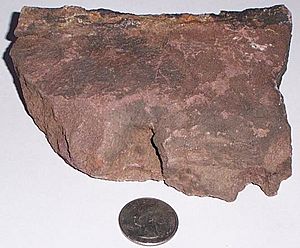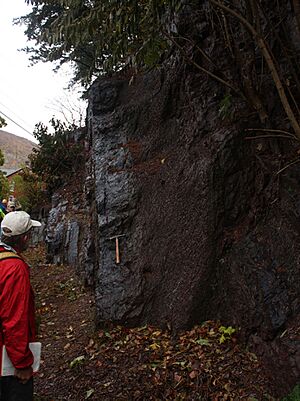Bloomsburg Formation facts for kids
Quick facts for kids Bloomsburg FormationStratigraphic range: Gorstian - Ludfordian ~425Ma |
|
|---|---|

A hand sample of the Bloomsburg Siltstone from Port Clinton, Pennsylvania
|
|
| Type | sedimentary |
| Underlies | Wills Creek Formation |
| Overlies | Clinton Group, McKenzie Formation, Mifflintown Formation, and Shawangunk Formation |
| Thickness | up to 5,000 feet (1,520 m) |
| Lithology | |
| Primary | Siltstone |
| Other | Shale, Claystone, Sandstone, Limestone |
| Location | |
| Region | Appalachian Basin of eastern North America |
| Extent | Maryland, New Jersey, New York, Pennsylvania, and Virginia |
| Type section | |
| Named for | Bloomsburg, Pennsylvania |
| Named by | I. C. White, 1883 |
The Silurian Bloomsburg Formation is a type of rock found in Pennsylvania, New Jersey, New York, and Maryland. It gets its name from the town of Bloomsburg, Pennsylvania, where it was first studied. This rock layer was the first time scientists found red sedimentary rocks in the Appalachian Basin area.
Contents
What is the Bloomsburg Formation?
The Bloomsburg Formation is mostly made of reddish-gray and greenish-gray claystone (a rock made from clay), siltstone (a rock made from silt), shale (a soft, layered rock), and fine-grained sandstone. These rocks are often found in layers that show a pattern: coarser (bigger) grains at the bottom, getting finer (smaller) towards the top.
Even though some parts can be green or gray, the most common color is red. This is why it's often called "The Bloomsburg Red Beds." This is a big deal in the Appalachian Basin. It means these rocks were the first large collection of sediments that formed on land, not in the ocean. Most of the rocks laid down before this time were formed in the sea.
In New Jersey, the Bloomsburg Red Beds used to be known by different names, like "High Falls Shale" or "High Falls Formation."
How Did These Rocks Form?
The Bloomsburg Formation mostly formed on land or in shallow water. Imagine rivers and floods carrying mud, silt, and sand from rising mountains. This material settled and eventually turned into rock. The red color of the rocks is a clue! It often means the sediments were laid down in dry places or where there was a lot of oxygen in the air. The very top layers of the Bloomsburg Formation seem to have formed in a shallow sea, showing a change from land to water environments.
Layers of Rock: Stratigraphy
Early geologists in America thought these red rocks were similar to the "Old Red Sandstone" found in Scotland. However, the Old Red Sandstone is much younger, from the Devonian Period.
The Bloomsburg Formation sits directly on top of older rock layers like the Clinton Group and Shawangunk Formation. What's above the Bloomsburg can be a bit tricky. In eastern Pennsylvania and New Jersey, there's a gap in the rock record called the Wallbridge Unconformity above it. But further west, other rock layers like the Wills Creek Formation or parts of the Mifflintown Formation lie on top. Sometimes, the Bloomsburg Formation even blends into the Mifflintown Formation.
Ancient Life: Fossils
Scientists have found many fossils in the Bloomsburg Formation, especially in its upper parts. These include trace fossils (like footprints or burrows) from some of the earliest land plants. There are also brachiopod fossils, which are shell creatures that lived in the sea, found in the upper layers that formed in marine environments.
Where to See the Bloomsburg Formation
You can see good examples of the Bloomsburg Formation in these places:
- Roundtop Hill, Maryland, near the railroad tracks.
- Port Clinton, Pennsylvania, where the rock layers stand almost straight up.
- Along U.S. Route 22, about 2.3 kilometers northeast of Canoe Creek.
How Old is It?
The Bloomsburg Formation formed during the Upper Silurian period. This means these rocks are very old, dating back about 417 to 410 million years ago!
What is it Used For?
The Bloomsburg Formation is useful to people today. The clay and other materials from these rocks are used to make bricks and other clay products. It's also sometimes used as a local building stone.


